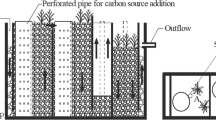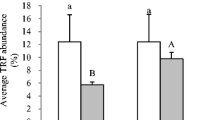Abstract
Three macrophyte species, Typha augustifolia (T. augustifolia), Phragmites australis (P. australis), and Acorus calamus L. (A. calamus L.), have been grown in hydroponic cultivation systems fed with synthetic wastewater. The experiment was designed as 3 × 2 factorial, with three species and two ratios of NH4 +/NO3 − so as to investigate the nitrogen transformation and nitrogen removal capacity of each species. The nitrogen removal mechanism was further disclosed by comparing biomass production, nitrogen mass balance, and root exudates of the three plant species under different NH4 +/NO3 − ratios. The results indicated there exists a linear relationship, with positive significance (r = 0.946, p < 0.05), between plant biomass and total nitrogen (TN) removal efficiency; in other words, biomass could best reflect plant ability to remove nitrogen. It is also found that NH4 +/NO3 − ratio could influence plant biomass and root exudates significantly. Additionally, the hydrogen donor and source of energy in denitrification happened in this research were mainly organic acids and soluble sugars, accounting for approximately 50 % of the composition in root exudates.





Similar content being viewed by others
References
Akratos, C. S., & Tsihrintzis, V. A. (2007). Effect of temperature, HRT, vegetation and porous media on removal efficiency of pilot-scale horizontal subsurface flow constructed wetlands. Ecological Engineering, 29(2), 173–191.
Ali, A., Tucker, T. C., Thompson, T. L., & Salim, M. (2001). Effects of salinity and mixed ammonium and nitrate nutrition on the growth and nitrogen utilization of barley. Journal of Agronomy and Crop Science-Zeitschrift Fur Acker Und Pflanzenbau, 186(4), 223–228.
Anderson, D. M., Glibert, P. M., & Burkholder, J. M. (2002). Harmful algal blooms and eutrophication: nutrient sources, composition, and consequences. Estuaries, 25(4B), 704–726.
Bloom, A. J., Sukrapanna, S. S., & Warner, R. L. (1992). Root respiration associated with ammonium and nitrate absorption and assimilation by barley. Plant Physiology, 99(4), 1294–1301.
Borin, M., & Salvato, M. (2012). Effects of five macrophytes on nitrogen remediation and mass balance in wetland mesocosms. Ecological Engineering, 46, 34–42.
Borin, M., & Tocchetto, D. (2007). Five year water and nitrogen balance for a constructed surface flow wetland treating agricultural drainage waters. Science of the Total Environment, 380(1–3), 38–47.
Brueck, H., & Guo, S. (2006). Influence of N form on growth and photosynthesis of Phaseolus vulgaris L. plants. Journal of Plant Nutrition and Soil Science-Zeitschrift Fur Pflanzenernahrung Und Bodenkunde, 169(6), 849–856.
Cea-Barcia, G., Buitron, G., Moreno, G., & Kumar, G. (2014). A cost-effective strategy for the bio-prospecting of mixed microalgae with high carbohydrate content: diversity fluctuations in different growth media. Bioresource Technology, 163, 370–373.
Chang, J., Liu, D., Cao, H., Chang, S. X., Wang, X., Huang, C., et al. (2010). NO3 −/NH4 + ratios affect the growth and N removal ability of Acorus calamus and Iris pseudacorus in a hydroponic system. Aquatic Botany, 93(4), 216–220.
Chung, A. K. C., Wu, Y., Tam, N. F. Y., & Wong, M. H. (2008). Nitrogen and phosphate mass balance in a sub-surface flow constructed wetland for treating municipal wastewater. Ecological Engineering, 32(1), 81–89.
Coleman, J., Hench, K., Garbutt, K., Sexstone, A., Bissonnette, G., & Skousen, J. (2001). Treatment of domestic wastewater by three plant species in constructed wetlands. Water, Air, and Soil Pollution, 128(3–4), 283–295.
Guo, S., Bruck, H., & Sattelmacher, B. (2002). Effects of supplied nitrogen form on growth and water uptake of French bean (Phaseolus vulgaris L.) plants—nitrogen form and water uptake. Plant and Soil, 239(2), 267–275.
Hoagland, D. R., & Arnon, D. I. (1950). The water culture method for growing plants without soil. Circular California Agricultural Experiment Station, 347, 1–32.
Krywult, M., Smykla, J., & Wincenciak, A. (2013). The presence of nitrates and the impact of ultraviolet radiation as factors that determine nitrate reductase activity and nitrogen concentrations in Deschampsia antarctica Desv. around penguin rookeries on King George Island, Maritime Antarctica. Water Air Soil Pollut, 224(5), 1563.
Kumar, D., Shivay, Y. S., Dhar, S., Kumar, C., & Prasad, R. (2013). Rhizospheric flora and the influence of agronomic practices on them: a review. Proceedings of the National Academy of Sciences India Section B-Biological Sciences, 83(1), 1–14.
Kumar, G., Zhen, G. Y., Kobayashi, T., Sivagurunathan, P., Kim, S. H., & Xu, K. Q. (2016). Impact of pH control and heat pre-treatment of seed inoculum in dark H-2 fermentation: a feasibility report using mixed microalgae biomass as feedstock. International Journal of Hydrogen Energy, 41(7), 4382–4392.
Landi, L., Valori, F., Ascher, J., Renella, G., Falchini, L., & Nannipieri, P. (2006). Root exudate effects on the bacterial communities, CO2 evolution, nitrogen transformations and ATP content of rhizosphere and bulk soils. Soil Biology & Biochemistry, 38(3), 509–516.
Lasa, B., Frechilla, S., Lamsfus, C., & Aparicio-Tejo, P. M. (2001). The sensitivity to ammonium nutrition is related to nitrogen accumulation. Scientia Horticulturae, 91(1–2), 143–152.
Lee, C. G., Fletcher, T. D., & Sun, G. Z. (2009). Nitrogen removal in constructed wetland systems. Engineering in Life Sciences, 9(1), 11–22.
Li, J., Zhou, J. M., & Duan, Z. Q. (2007). Effects of elevated CO2 concentration on growth and water usage of tomato seedlings under different ammonium/nitrate ratios. Journal of Environmental Sciences-China, 19(9), 1100–1107.
Li, M., Sheng, G. P., Wu, Y. J., Yu, Z. L., Banuelos, G. S., & Yu, H. Q. (2014). Enhancement of nitrogen and phosphorus removal from eutrophic water by economic plant annual ryegrass (Lolium multiflorum) with ion implantation. Environmental Science and Pollution Research, 21(16), 9617–9625.
Lin, Y. F., Jing, S. R., Wang, T. W., & Lee, D. Y. (2002). Effects of macrophytes and external carbon sources on nitrate removal from groundwater in constructed wetlands. Environmental Pollution, 119(3), 413–420.
Liu, D., Ge, Y., Chang, J., Peng, C., Gu, B., Chan, G. Y. S., et al. (2009). Constructed wetlands in China: recent developments and future challenges. Frontiers in Ecology and the Environment, 7(5), 261–268.
Lurling, M., & van Oosterhout, F. (2013). Controlling eutrophication by combined bloom precipitation and sediment phosphorus inactivation. Water Research, 47(17), 6527–6537.
Ma, X., Ma, F., Li, C., Mi, Y., Bai, T., & Shu, H. (2010). Biomass accumulation, allocation, and water-use efficiency in 10 Malus rootstocks under two watering regimes. Agroforestry Systems, 80(2), 283–294.
Rewald, B., Kunze, M. E., & Godbold, D. L. (2016). NH4: NO3 nutrition influence on biomass productivity and root respiration of poplar and willow clones. Global Change Biology Bioenergy, 8(1), 51–58.
Ruan, J., Gerendas, J., Hardter, R., & Sattelmacher, B. (2007). Effect of nitrogen form and root-zone pH on growth and nitrogen uptake of tea (Camellia sinensis) plants. Annals of Botany, 99(2), 301–310.
Salvato, M., Borin, M., Doni, S., Macci, C., Ceccanti, B., Marinari, S., et al. (2012). Wetland plants, micro-organisms and enzymatic activities interrelations in treating N polluted water. Ecological Engineering, 47, 36–43.
Sanchez-Carrillo, S., & Alvarez-Cobelas, M. (2001). Nutrient dynamics and eutrophication patterns in a semi-arid wetland: the effects of fluctuating hydrology. Water, Air, and Soil Pollution, 131(1–4), 97–118.
Sundaravadivel, M., & Vigneswaran, S. (2001). Constructed wetlands for wastewater treatment. Critical Reviews in Environmental Science and Technology, 31(4), 351–409.
Tanner, C. C. (2001). Growth and nutrient dynamics of soft-stem bulrush in constructed wetlands treating nutrient-rich wastewaters. Wetlands Ecology and Management, 9(1), 49–73.
Tanner, C. C., Kadlec, R. H., Gibbs, M. M., Sukias, J. P. S., & Nguyen, M. L. (2002). Nitrogen processing gradients in subsurface-flow treatment wetlands—influence of wastewater characteristics. Ecological Engineering, 18(4), 499–520.
Vymazal, J. (2005). Horizontal sub-surface flow and hybrid constructed wetlands systems for wastewater treatment. Ecological Engineering, 25(5), 478–490.
Vymazal, J. (2007). Removal of nutrients in various types of constructed wetlands. Science of the Total Environment, 380(1–3), 48–65.
Wang, Z., Zhang, Z., Zhang, Y., Zhang, J., Yan, S., & Guo, J. (2013). Nitrogen removal from Lake Caohai, a typical ultra-eutrophic lake in China with large scale confined growth of Eichhornia crassipes. Chemosphere, 92(2), 177–183.
Yin, H. J., Li, Y. F., Xiao, J., Xu, Z. F., Cheng, X. Y., & Liu, Q. (2013). Enhanced root exudation stimulates soil nitrogen transformations in a subalpine coniferous forest under experimental warming. Global Change Biology, 19(7), 2158–2167.
Zhai, X., Piwpuan, N., Arias, C. A., Headley, T., & Brix, H. (2013). Can root exudates from emergent wetland plants fuel denitrification in subsurface flow constructed wetland systems? Ecological Engineering, 61, 555–563.
Zhen, G. Y., Lu, X. Q., Kobayashi, T., Kumar, G., & Xu, K. Q. (2016). Anaerobic co-digestion on improving methane production from mixed microalgae (Scenedesmus sp., Chlorella sp.) and food waste: kinetic modeling and synergistic impact evaluation. Chemical Engineering Journal, 299, 332–341.
Zhu, L., Li, Z., & Ketola, T. (2011). Biomass accumulations and nutrient uptake of plants cultivated on artificial floating beds in China’s rural area. Ecological Engineering, 37(10), 1460–1466.
Acknowledgments
The authors are grateful for the financial support of the Major Science and Technology Program for Water Pollution Control and Treatment of China (No. 2012ZX07105-003).
Author information
Authors and Affiliations
Corresponding author
Rights and permissions
About this article
Cite this article
Wu, H., Xu, K., He, X. et al. Removal of Nitrogen by Three Plant Species in Hydroponic Culture: Plant Uptake and Microbial Degradation. Water Air Soil Pollut 227, 324 (2016). https://doi.org/10.1007/s11270-016-3036-3
Received:
Accepted:
Published:
DOI: https://doi.org/10.1007/s11270-016-3036-3




